|
Water Rockets
Launcher Index
When launching a  rocket like the one on
the right, it goes without saying that a launcher of some
sort is needed. rocket like the one on
the right, it goes without saying that a launcher of some
sort is needed.
This index will,
hopefully, give you a starting point for building a
launcher of your own.
The methods I
have used here are suited to the situation regarding
materials availability that I have found myself in, in
the UK - things are different elsewhere in the world and
I suggest that you use the information and ideas that are
on this site along with the content of other sites to
come to a design of your own that suits your needs.
Discussion
Discussion
about fundementals of different types of laucher.
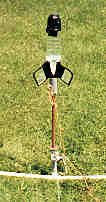 Copper Tube Launcher Copper Tube Launcher
This is the launcher
that I built using materials available in the
UK. It is an outside groove sealing launcher
built from copper and it allows you to launch
using restricted nozzles if you wish.
Modification
for use with only an air line
Following a question on the group, I came
up with this
design - there is another way of
doing it using a double acting piston and a
one-way valve
|
|
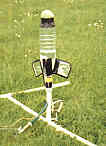 Hose Connector Launcher Hose Connector Launcher
This launcher
is extremely easy to build. It uses basic
parts that are available in any reasonable
hardware shop. It is made from quick connect
lawn hose parts and allows you to launch a
rocket with a reduced nozzle. The use of the
launcher is extremely strightforward.
|
|
Launcher
Bases
Stakes have the advantage that you just need to
knock them into the ground and once there, they will
not slide all over the place then your ground crew
pulls the launcher release too enthusiastically.
However, a hot, dry summer will render them useless
when the ground dries up. A H-Base will just sit on
the surface and is easy to set up although the can
fall over if care is not take with them or
precautions such as staking the ends of the feet with
6" nails :-)
Stake
This is shown on the Copper
Tube launcher with a swingball base
along with a piece of wood as a support and some
cable ties to hold everything in place. Basic but
quick to as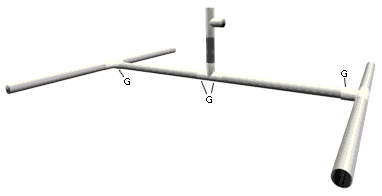 semble and sturdy. semble and sturdy.
H-Base
This is a more civilised and better looking
base for the launcher. The H-Base
is lighter and more portable, quick to assemble
and can be used on hard ground.
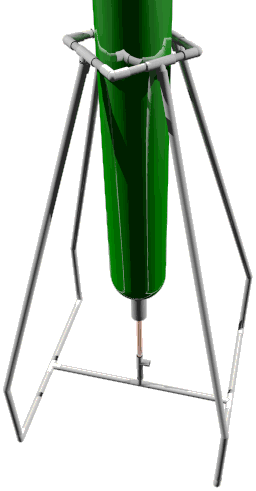 Gantry Gantry
The Gantry
is for those larger rokets (10 litres or bigger,
2 stage using 3 litre bottles on the booster)
that are too heavy and have a centre of gravity
too high for the launcher on its own.
Performance
Improvements
The basic launcher will get your rocket into the
air without getting you wet but there are still some
things that you can do that will improve the
performance of your flights.
Restricted
Nozzles
The copper tube launcher allows you to use a
restricted nozzle on the rocket. One of the main
considerations regarding performance is that of
drag and this force increases proportionally to
the square of the velocity. Keeping the speed
down will reduce this force and by reducing the
diameter of the nozzle, the 'burn' will last
longer resulting in a greater height (a gain
of around 3 metres - see table below).
Nozzle restrictions are shown in the variations
section of the Copper
Tube launcher page.
The hose
connector launcher uses a restricted
nozzle to work.
Launch
Tubes
 A
Launch
Tube is a tube that acts like a
plunger inside the nozzle allowing an extra,
initial push with very little loss of water in
the process. This can give the rocket an initial
burst allowing it to get to a greater height
without having to carry as much water. A hollow
tube will give better results as the air inside
the launch tube will contribute to the total air
of the rocket while it is on the tube (Use the Water Rocket Computer
Model to play around with this - the
effect is significant but becomes more so as the
volume of the launch tube becomes a greater
proportion of the capacity of the rocket's
pressure vessel). A height gain over the launch
tubeless, fully open nozzle of around 7 metres. A
Launch
Tube is a tube that acts like a
plunger inside the nozzle allowing an extra,
initial push with very little loss of water in
the process. This can give the rocket an initial
burst allowing it to get to a greater height
without having to carry as much water. A hollow
tube will give better results as the air inside
the launch tube will contribute to the total air
of the rocket while it is on the tube (Use the Water Rocket Computer
Model to play around with this - the
effect is significant but becomes more so as the
volume of the launch tube becomes a greater
proportion of the capacity of the rocket's
pressure vessel). A height gain over the launch
tubeless, fully open nozzle of around 7 metres.
T-nozzles
 Combining
the benefits of a small nozzle
diameter with a launch tube, a T-nozzle is a
device that sits on top of the launch tube while
the rocket is on the launcher. When the rocket is
released, the launch tube provides as much
acceleration as possible with as little loss of
liquid as possible until the nozzle reaches the
end of the launch tube. Then, the T-nozzle
engages, sealing off the full bore nozzle with a
smaller nozzle which allows the slower release of
water during the rest of the burn. This allows
even greater height gains as even less water is
needed. Again, with a standard 130g rocket at 5.1
Barg, a T-Nozzle gives a gain of nearly 19
metres, beating the launch tube only by over 10
metres. Combining
the benefits of a small nozzle
diameter with a launch tube, a T-nozzle is a
device that sits on top of the launch tube while
the rocket is on the launcher. When the rocket is
released, the launch tube provides as much
acceleration as possible with as little loss of
liquid as possible until the nozzle reaches the
end of the launch tube. Then, the T-nozzle
engages, sealing off the full bore nozzle with a
smaller nozzle which allows the slower release of
water during the rest of the burn. This allows
even greater height gains as even less water is
needed. Again, with a standard 130g rocket at 5.1
Barg, a T-Nozzle gives a gain of nearly 19
metres, beating the launch tube only by over 10
metres.
Look at Scott Chesnut's site and Brad Calvert's site for
T-Nozzles.
| Description |
Parameters |
Flight
Height |
Weight
Water |
Nozzle
Diameter |
Launch
Tube
Diameter |
Launch
Tube
Length |
T-Nozzle
Diameter |
| Units |
g |
mm |
mm |
cm |
mm |
m |
| Basic 2 litre |
550 |
21.75 |
- |
- |
- |
52.2 |
| Restricted Nozzle |
550 |
8.0 |
- |
- |
- |
55.3 |
| Launch Tube |
440 |
21.75 |
21.5 |
25 |
- |
59.7 |
| T-Nozzle |
415 |
21.75 |
21.5 |
25 |
3.7 |
71.1 |
Comparison of
different launch types on basic 2 litre bottle
weighing 130g pressurised to 5.1 BarG
General
Improvements
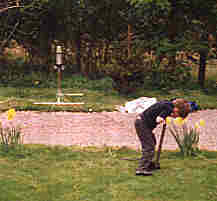 All of the above relate to the
fundemental functioning of the launcher and the
rocket. However, there are some other improvements
that can be made to improve on safety and
convenience. All of the above relate to the
fundemental functioning of the launcher and the
rocket. However, there are some other improvements
that can be made to improve on safety and
convenience.
Air Line
Using an air line will put valuable distance
between yourself and the rocket whilst you are
pressurising it. Should the rocket fail
catastrophically, the further you are away from
it when it does this, the better. I use a 5 metre
¼" diameter flexible PVC tube with a
one-way valve at the pump end as filling this
air-line at 5 BarG will take one pump stroke so
keeping it up to pressure means that all of my
efforts fill the rocket rather than repressurise
the air-line with each stroke of the pump.
5 metres relates to the amount of cash I had
in my pocket when I bought the tubing but is
reasonable for pumping ductile plastic pressure
vessels to 5 BarG. For higher pressures I would
recommend at least 10 metres, maybe 20. Remember
to pressure test anything that you are using - I
cannot be held responsible if you fail to carry
out simple testing procedures.
Air Pump
A hand-held bicycle pump is all right for a
start but if you are going to pressurise many
rockets, a stirrup pump is far better. I have one
with a metal casing and pressure gauge that will
pump to a pressure of 10 BarG (I have tried this)
and is a lot easier to use than a hand held pump.
Being able to put your weight onto a handle that
you can hold with both hands is a lot easier than
using a hand held unless you really want to
develop your chest muscles.
An alternative is to use an electric pump that
runs from a car battery but thought should be
given to:
- Its cost;
- How much effort will be required to get
it to any launch site (carrying the pump
and associated batteries);
- The effects on its longevity caused by
pumping hundereds of litres of air
through it at 5 BarG instead of topping
up the pressure of a few car tyres to 2
or so BarG every few months; and,
- The fact that if you are going to have to
pressurise 30 rockets for a school
science class in as many minutes, you
will still be able to stand without the
aid of pure oxygen at the end of it by
using an electric pump.
Water
Delivery
Filling a rocket and then putting it on the
launcher - whether you do this on the ground and
spill some of the water or you put the launcher
on the rocket and then turn the rocket with the
launcher the right way up - is not as convenient
as being able to mount the empty rocket on the
launcher (being able to position the T-Nozzle)
and then fill it to exactly the right level.
Using a pressurised water reservoir has the
advantage of reducing handling problems and
making launches more reproducable. The
disadvantage is that you will be using the same
pressure vessel each time and thought should be
given to the expected life of this vessel bearng
in mind the fact that it will get more sunlight
and be pressurised for longer than the rockets
and therefore need to be replaced more
often. Once way around this is if you are
launching near to a water supply (if you launch
at home) in that the water is already pressurised
and in a useful pipe.
Emergency
Pressure Dumping
Should you suspect that the rocket is about to
fail or, for some reason it does not launch, or
maybe an animal (such as dog or a boy scout)
strays into the launch area, you may wish to dump
the air as quickly as possible.
The best way of doing this is to use a launch
tube. If you are not using a launch tube to gain
extra height, a small diameter (6mm) tube will be
sufficient to dump the air in a rocket in a
reasonably short time - a launch tube used to
gain extra height will have a larger diameter but
you will still have to go through whatever size
of fitting you are using unless you operate an
emergency valve mounted on the side of the
launcher that, with the pull of a string, rotates
a ball valve through 90º and allows the air to
discharge quickly.
 Back to the Main Water Rocket Index Back to the Main Water Rocket Index

FastCounter by
bCentral
|
|
 rocket like the one on
the right, it goes without saying that a launcher of some
sort is needed.
rocket like the one on
the right, it goes without saying that a launcher of some
sort is needed. 



 A
A
 Combining
the benefits of a small nozzle
diameter with a launch tube, a T-nozzle is a
device that sits on top of the launch tube while
the rocket is on the launcher. When the rocket is
released, the launch tube provides as much
acceleration as possible with as little loss of
liquid as possible until the nozzle reaches the
end of the launch tube. Then, the T-nozzle
engages, sealing off the full bore nozzle with a
smaller nozzle which allows the slower release of
water during the rest of the burn. This allows
even greater height gains as even less water is
needed. Again, with a standard 130g rocket at 5.1
Barg, a T-Nozzle gives a gain of nearly 19
metres, beating the launch tube only by over 10
metres.
Combining
the benefits of a small nozzle
diameter with a launch tube, a T-nozzle is a
device that sits on top of the launch tube while
the rocket is on the launcher. When the rocket is
released, the launch tube provides as much
acceleration as possible with as little loss of
liquid as possible until the nozzle reaches the
end of the launch tube. Then, the T-nozzle
engages, sealing off the full bore nozzle with a
smaller nozzle which allows the slower release of
water during the rest of the burn. This allows
even greater height gains as even less water is
needed. Again, with a standard 130g rocket at 5.1
Barg, a T-Nozzle gives a gain of nearly 19
metres, beating the launch tube only by over 10
metres. All of the above relate to the
fundemental functioning of the launcher and the
rocket. However, there are some other improvements
that can be made to improve on safety and
convenience.
All of the above relate to the
fundemental functioning of the launcher and the
rocket. However, there are some other improvements
that can be made to improve on safety and
convenience.